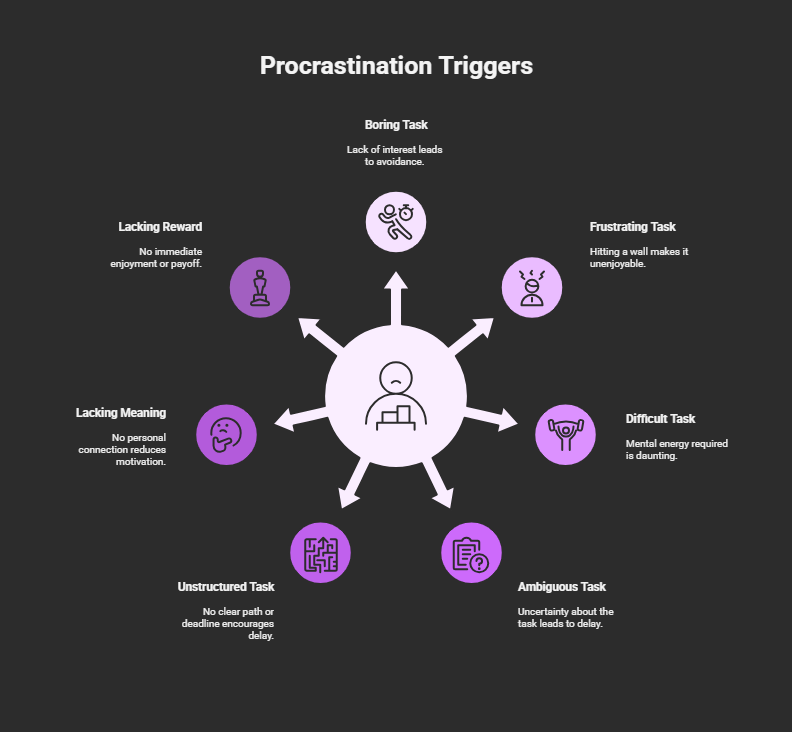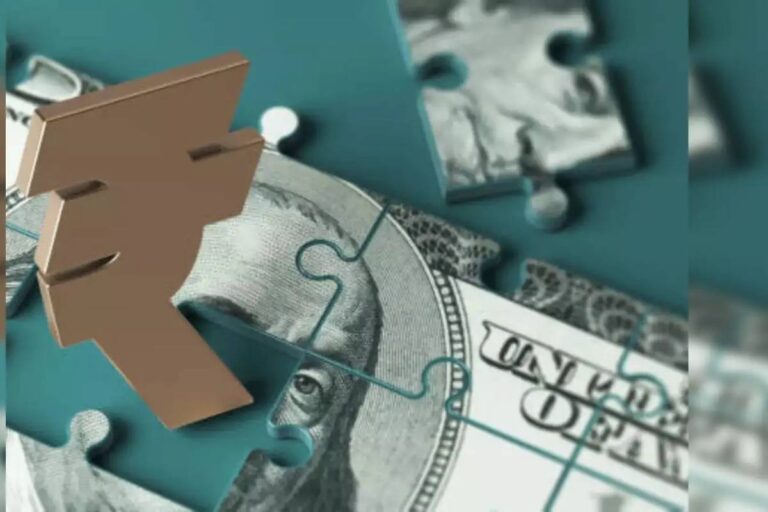You’re staring at a deadline. A big one. The kind that makes your stomach do a little flip-flop. You know you should start. You want to start. But instead, you find yourself organizing your spice rack, scrolling through pictures of your second cousin’s vacation, or suddenly developing an urgent need to learn everything about the migratory patterns of the Arctic tern.
Sound familiar?
Of course, it does. This is the classic dance of procrastination, a routine so many of us know by heart. We beat ourselves up over it, label ourselves as lazy, and promise, oh, how we promise, that tomorrow will be different.
But here’s the kicker: What if I told you that your brain, in its own weird, short-sighted way, is loving this little detour? What if that urge to put things off isn’t a character flaw, but a deeply ingrained neurological response?
It’s true. Procrastination isn’t about laziness. Not really. It’s about a full-blown war happening inside your head. A battle between two powerful, competing forces in your brain. And believe it or not, understanding this war is the first step to finally winning it.
The Main Event: A Tale of Two Brains
Picture this. In one corner of the ring, we have the limbic system. This is the old-school, reptilian part of your brain. It’s been around forever. It’s primal, powerful, and it runs on one simple principle: “If it feels good, do it. If it feels bad, run away.” It’s your brain’s center for emotions, pleasure, and survival instincts. It’s the part of you that craves a warm cookie, a good laugh, or the mindless comfort of a Netflix binge. The limbic system is all about the now. The immediate. The instant gratification.
And in the other corner? The prefrontal cortex. This is the new kid on the block, evolutionarily speaking. Located right behind your forehead, it’s the CEO of your brain. It’s responsible for all the adulting stuff: planning, decision-making, impulse control, and thinking about long-term consequences. Your prefrontal cortex is the part of you that says, “Hey, maybe we should work on that report now so we’re not in a full-blown panic on Friday.” It’s the voice of reason, the long-term strategist.
So, you have a big, scary, and maybe a little bit boring task in front of you. That project you’ve been avoiding? To your limbic system, it feels like a threat. It’s difficult, it’s uncertain, and the reward, a good grade, a completed project, a sense of accomplishment, is way off in the future. The limbic system, bless its simple heart, throws up a red flag. It screams, “Danger! This feels bad! Let’s do something else. Anything else?”
And that’s when it happens. The amygdala, a little almond-shaped part of the limbic system that acts as your brain’s alarm bell, starts going off. It associates the task with negative feelings, fear of failure, boredom, and frustration. It triggers a fight-or-flight response. And in this case, “flight” looks a lot like opening a new tab and falling down a YouTube rabbit hole.
Your prefrontal cortex, the logical CEO, tries to step in. It says, “Now, hold on a minute. We have a plan. This is important.” But here’s the thing: the limbic system is a much more established, much more automatic part of your brain. It’s got a direct line to your emotions and your gut feelings. When that emotional alarm bell is ringing, it’s incredibly hard for the calm, rational voice of the prefrontal cortex to get a word in edgewise. It’s like trying to have a serious conversation while a fire alarm is blaring.
This, right here, is the neuroscience of procrastination in a nutshell. It’s a temporary victory for the emotional, short-sighted limbic system over the logical, forward-thinking prefrontal cortex.
The Sweet, Sweet Poison of Dopamine
So, why does giving in to procrastination feel so… good? Even when we know we’re just digging a deeper hole for ourselves?
dopamine.
Dopamine is a neurotransmitter, a chemical messenger in your brain. It’s often called the “feel-good” chemical, but that’s a bit of an oversimplification. Dopamine is more about motivation and reward. It’s released when we anticipate something pleasurable. When you see a delicious piece of cake, your dopamine levels start to rise in anticipation of eating it. When you get a notification on your phone, you get a little hit of dopamine, anticipating a like or a message.
And this is where the instant gratification trap is sprung.
When you’re faced with that daunting task, your brain is in a state of discomfort. The amygdala is firing, you’re feeling anxious, and the whole situation is just… unpleasant. Then, you think of something else. Something easy and enjoyable. Checking your email. Playing a game on your phone. Making a snack.
The moment you switch to that easier, more pleasurable activity, your brain releases a hit of dopamine. Ahhh, relief. That feels so much better. The anxiety from the big task recedes, and you’re rewarded with a little burst of pleasure.
Your brain, being the efficient learning machine that it is, quickly makes a connection: “When I avoid that big, scary task and do this fun thing instead, I get a reward.” Every time you procrastinate, you’re essentially training your brain to do it again. You’re reinforcing the neural pathway that says, “Avoidance = Pleasure.”
It’s a vicious cycle, isn’t it? The more you do it, the stronger that connection becomes. The procrastination habit gets more and more ingrained. It’s not a conscious choice, most of the time. It’s a learned, automatic response, driven by the powerful allure of a quick and easy dopamine fix.
Funny thing is, this system is designed to help us survive. In our evolutionary past, it made sense to prioritize immediate rewards and avoid immediate threats. Finding a berry bush was a more pressing concern than, say, planning for next year’s harvest. But in our modern world, filled with long-term projects and abstract goals, this ancient wiring often works against us.
Are You a Procrastinator? (Spoiler: Yes, and That’s Okay)

Let’s be honest. Everyone procrastinates. If someone tells you they’ve never put something off, they’re either a robot or they’re lying. The question isn’t if you procrastinate, but why and how much.
Researchers have identified a few common triggers that make a task more “procrastination-worthy”:
- Boring: It’s just not interesting. Your brain would rather do anything else.
- Frustrating: You feel like you’re hitting a wall, and it’s just not enjoyable.
- Difficult: It requires a lot of mental energy, and you’re not sure you can do it.
- Ambiguous: You’re not entirely sure what you’re supposed to do or how to start.
- Unstructured: There’s no clear path or deadline, so it’s easy to let it slide.
- Lacking in personal meaning: You don’t see the point, so you have no intrinsic motivation.
- Lacking in intrinsic reward: The task itself isn’t enjoyable, and the payoff is too far away.
Do any of these sound like the tasks you tend to put off? Chances are, they tick at least one of these boxes.
And here’s something else to consider: your emotional state plays a huge role. If you’re feeling stressed, anxious, or insecure, your amygdala is already on high alert. This makes it even easier for your limbic system to take over and steer you towards the comforting embrace of procrastination. It’s a form of mood regulation. You’re feeling bad, so you do something to feel better in the short term, even if it makes you feel worse in the long run.
Rewiring Your Brain: How to Fight Back and Win the War
Okay, so we’ve established that your brain is wired for procrastination. It’s a biological reality. Does that mean we’re doomed to a life of last-minute panic and half-finished projects?
Absolutely not.
The amazing thing about the brain is its neuroplasticity. This fancy word simply means that your brain can change. It can form new connections, strengthen existing ones, and weaken others. You can, quite literally, rewire your brain to be less prone to procrastination. You can train your prefrontal cortex to be stronger and your limbic system to have less of a say in your decisions.
It takes effort, for sure. But it’s possible. Here’s how you can start.
Train Your Prefrontal Cortex: The CEO Workout
Your prefrontal cortex is like a muscle. The more you use it, the stronger it gets. Here are some exercises to bulk it up:
- The 5-Minute Rule: This one is a game-changer. The hardest part of any task is starting. So, make a deal with yourself. You’re just going to work on that dreaded task for five minutes. That’s it. Anyone can do anything for five minutes, right? Set a timer. More often than not, once you get over that initial hump and start to make a little progress, the task will feel less daunting. And you might just find yourself wanting to continue after the timer goes off. You’re gently overriding the amygdala’s initial “NOPE!” signal.
- Break It Down (Like, Really Down): A huge project is overwhelming. “Write a 20-page report” is enough to send anyone running for the hills. But “open a new document and write a title”? That’s manageable. “Find three sources for the introduction”? Doable. Break your task down into the smallest possible steps. Each time you check off one of those tiny steps, you get a little hit of dopamine. You’re creating a new reward system, one that’s tied to making progress on your long-term goals. You’re essentially creating a trail of breadcrumbs for your brain to follow.
- The Pomodoro Technique: This is a classic for a reason. You work in focused 25-minute intervals, with a 5-minute break in between. After four “pomodoros,” you take a longer break. This technique does a couple of brilliant things. First, it makes the task feel less endless. “I just have to focus for 25 minutes” is much less scary than “I have to work for the next three hours.” Second, it builds in regular rewards (the breaks), which helps to keep your limbic system happy.
Tame the Beast: Calming Your Limbic System
You can’t just ignore your limbic system. It’s too powerful. But you can learn to manage it.
- Mindfulness and Meditation: This is huge. Research has shown that regular mindfulness practice can shrink the amygdala and strengthen the connections between the amygdala and the prefrontal cortex. When you meditate, you’re practicing observing your thoughts and feelings without immediately reacting to them. You’re learning to say, “Ah, there’s that feeling of anxiety about this task. Interesting.” instead of letting it hijack your behavior. Even a few minutes of deep breathing when you feel the urge to procrastinate can be enough to calm your nervous system and allow your prefrontal cortex to come back online.
- Cognitive Reframing: How you think about a task has a massive impact on how you feel about it. If you’re telling yourself, “This is going to be awful. I’m so bad at this,” of course, you’re going to want to avoid it. Try reframing your thoughts. Instead of “I have to do this,” try “I get to do this” or “I choose to do this.” Instead of focusing on the difficulty, focus on the benefits of getting it done. How will you feel when it’s finished? What will you have learned? You’re essentially changing the emotional “flavor” of the task, making it less aversive to your limbic system.
- Forgive Yourself: This might sound a little woo-woo, but it’s backed by science. Beating yourself up for procrastinating just adds another layer of negative emotions, guilt, and shame to the task. This makes you even more likely to avoid it in the future. Studies have shown that students who forgive themselves for procrastinating on one exam are less likely to procrastinate on the next one. So, be kind to yourself. Acknowledge that you slipped up, and then gently guide your focus back to the present moment and the next small step you can take.
Hack Your Dopamine: Create Your Reward System
Since your brain loves a good dopamine hit, why not use that to your advantage?
- Reward Your Effort, Not Just the Outcome: Don’t wait until the entire project is done to celebrate. Reward yourself for completing those small, broken-down steps. Finished a pomodoro? Enjoy that 5-minute break guilt-free. Wrote one page of that report? Allow yourself ten minutes of your favorite podcast. You’re creating a positive feedback loop that associates productive behavior with pleasure.
- Visualize the Finish Line: Take a few moments to vividly imagine how good it will feel to have this task done. Picture yourself hitting “send” on that email, turning in that paper, or finishing that presentation. Imagine the relief, the sense of accomplishment, the freedom. This visualization can help to make the future reward feel more real and immediate, giving your prefrontal cortex more leverage in its battle with the limbic system.
The Takeaway: It’s Not You, It’s Your Brain
If there’s one thing to take away from all of this, it’s this: procrastination is not a moral failing. It’s a biological one. It’s the result of a very real, very ancient conflict playing out in your brain every single day.
So, the next time you find yourself alphabetizing your bookshelf when you should be doing your taxes, don’t despair. Don’t fall into the trap of self-blame. Instead, take a deep breath and acknowledge the battle that’s happening under the hood. Your limbic system is just trying to protect you from what it perceives as a threat.
But you, the conscious, thinking you, have the power to change the outcome. You can train your prefrontal cortex, soothe your limbic system, and create new, more productive habits. It’s a process. It takes time and practice. But with a little bit of self-awareness and a few of these neuroscience-backed strategies, you can start to tip the scales in your favor. You can learn to work with your brain instead of constantly fighting against it.
And that, my friend, is how you finally escape the instant gratification trap and start getting things done. It’s not about finding some magical source of motivation. It’s about understanding the war in your head… and knowing which side you want to help win. Give it a try. What have you got to lose? Except, of course, that lingering feeling of dread and that ever-growing to-do list. The choice, as always, is yours to make. And believe it or not, your brain is ready to listen.






















